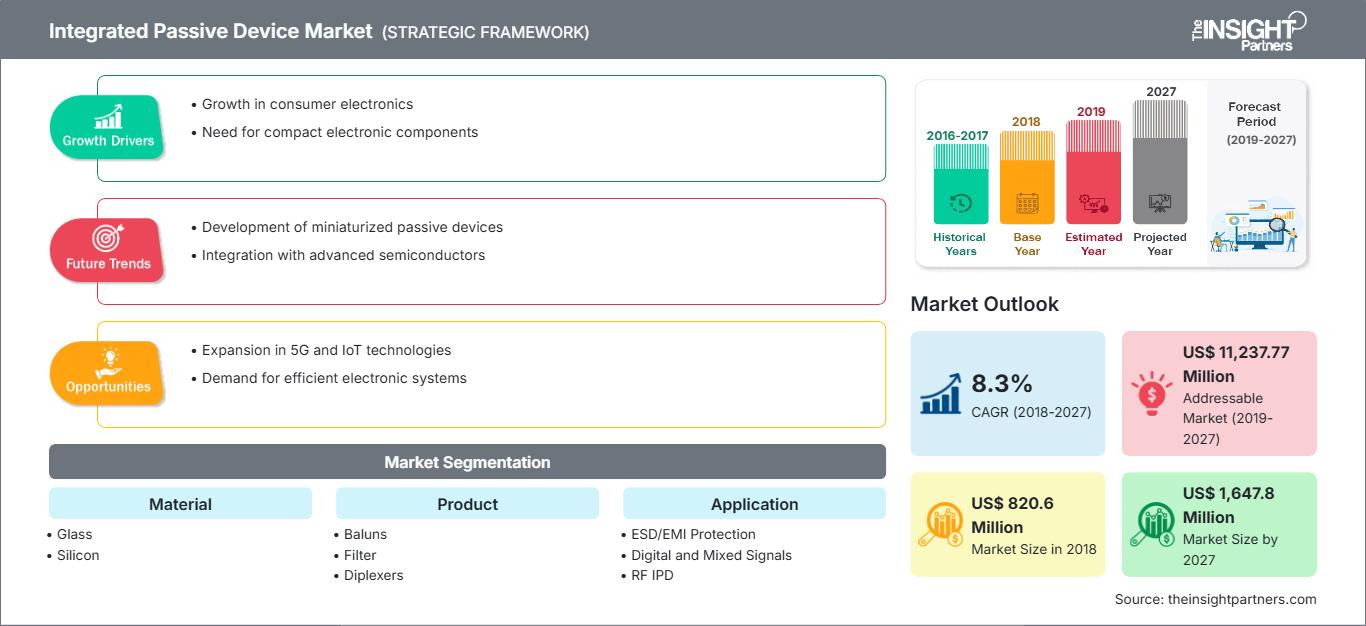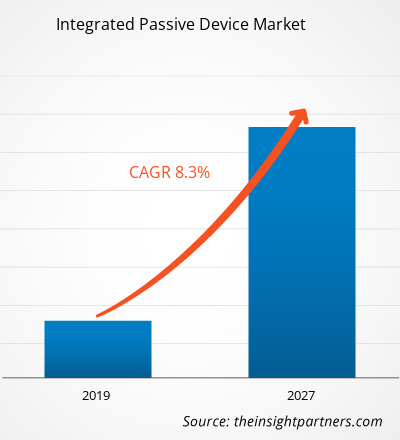Le marché mondial des dispositifs passifs intégrés représentait 820,6 millions de dollars américains en 2018 et devrait croître à un TCAC de 8,3 % au cours de la période de prévision 2019-2027, pour atteindre 1 647,8 millions de dollars américains d'ici 2027.
L'Asie-Pacifique devrait être le marché à la croissance la plus rapide sur le marché des dispositifs passifs intégrés. La région APAC comprend une vaste empreinte géographique qui intègre un grand nombre de croissances industrielles et économiques, qui prévoient une application massive des dispositifs passifs intégrés, ce qui accentuerait la croissance du marché des dispositifs passifs intégrés dans la région APAC. De plus, les pays d'Amérique du Nord ont connu une utilisation accrue de l'électronique grand public, car cette région comprend des pays technologiquement avancés, associés à des revenus disponibles élevés des particuliers, ce qui a permis à l'industrie de l'électronique grand public de prospérer dans la région. Les dépenses globales en électronique grand public enregistrées en Amérique du Nord en 2018 ont dépassé 115,9 milliards de dollars américains, ce qui devrait stimuler le marché des dispositifs passifs intégrés dans cette région.
Analyses du marché : Forte adoption de l'électronique grand public
Le secteur de l'électronique grand public connaît une croissance fulgurante à l'échelle mondiale, principalement due à la demande de miniaturisation. Aujourd'hui, de nombreux appareils électroniques grand public sont utilisés par les consommateurs du monde entier pour diverses tâches. Les appareils électroniques grand public tels que les tablettes, les montres connectées, les smartphones, etc., sont devenus un élément essentiel du mode de vie des utilisateurs. Grâce aux progrès technologiques, les appareils grand public deviennent plus intelligents. Les applications basées sur l'IA ont renforcé la demande de puces moins chères, nécessitant moins d'espace d'installation à l'intérieur de l'appareil. Le marché de l'électronique grand public connaît une croissance rapide, grâce à l'arrivée régulière de technologies avancées par plusieurs fabricants de semi-conducteurs, qui attirent l'industrie. Cela stimulera le marché des dispositifs passifs intégrés au cours de la période de prévision.
Personnalisez ce rapport en fonction de vos besoins
Vous bénéficierez d’une personnalisation sur n’importe quel rapport - gratuitement - y compris des parties de ce rapport, ou une analyse au niveau du pays, un pack de données Excel, ainsi que de profiter d’offres exceptionnelles et de réductions pour les start-ups et les universités
Marché des dispositifs passifs intégrés: Perspectives stratégiques

- Obtenez les principales tendances clés du marché de ce rapport.Cet échantillon GRATUIT comprendra une analyse de données, allant des tendances du marché aux estimations et prévisions.
Demande émergente de dispositifs passifs intégrés (DPI) personnalisés
Vous bénéficierez d’une personnalisation sur n’importe quel rapport - gratuitement - y compris des parties de ce rapport, ou une analyse au niveau du pays, un pack de données Excel, ainsi que de profiter d’offres exceptionnelles et de réductions pour les start-ups et les universités
Marché des dispositifs passifs intégrés: Perspectives stratégiques

- Obtenez les principales tendances clés du marché de ce rapport.Cet échantillon GRATUIT comprendra une analyse de données, allant des tendances du marché aux estimations et prévisions.
La demande croissante d'appareils électroniques avancés dans divers secteurs tels que les télécommunications, la santé, l'automobile et d'autres, ainsi que l'exigence de miniaturisation des appareils, augmentent. Les DPI sont intégrés à ces appareils électroniques, notamment : les DPI RF sont intégrés aux appareils connectés, notamment les téléphones portables et les tablettes. Ces produits sont interconnectés selon différents modes d'assemblage, tels que le câblage par fils et le micro-bumping, ce qui permet de les personnaliser selon les besoins du client. Les utilisateurs finaux exigent des fabricants de puces qu'ils personnalisent leurs puces en utilisant des DPI plutôt que des composants discrets pour répondre au besoin de miniaturisation des appareils. C'est la tendance actuelle du marché des dispositifs passifs intégrés.
Informations sur les matériaux
Le marché mondial des dispositifs passifs intégrés par matériau est dominé par le segment des matériaux en silicium. D'autres matériaux pris en compte sur le marché des dispositifs passifs intégrés incluent le verre, entre autres.
Aperçu des applications
Le marché des dispositifs passifs intégrés est segmenté par application en protection ESD/EMI, signaux numériques et mixtes, IPD RF, et autres. L'adoption croissante des appareils électroniques, de l'infodivertissement automobile, des appareils portables intelligents et autres dispositifs IoT. Cependant, l'évolution rapide des technologies nécessite des changements constants dans les équipements de fabrication. De plus, la prolifération des IPD personnalisés et l'essor de la technologie 5G devraient offrir des opportunités de croissance substantielles aux principaux acteurs du marché des dispositifs passifs intégrés.
Les nouvelles initiatives commerciales ont été observées comme la stratégie la plus adoptée sur le marché mondial des dispositifs passifs intégrés. Voici quelques initiatives récentes du marché : 2019 : STMicroelectronics a annoncé sa collaboration avec Truphone afin de fournir sa technologie à Murata pour le lancement d'un module cellulaire basse consommation destiné aux appareils IoT/M2M. 2018 : 3D Glass Solutions a annoncé l'installation de son nouveau siège social à Albuquerque, ainsi qu'un investissement d'environ 23 millions de dollars américains pour les cinq prochaines années. Grâce à cette expansion, l'entreprise se concentre sur une croissance continue dans le secteur des sciences et des technologies. 2018 : NXP Semiconductors a signé un accord avec Tata Consultancy Services pour collaborer sur des solutions uniques destinées aux secteurs de l'automobile, de la sécurité et de l'IoT.
Aperçu régional du marché des dispositifs passifs intégrés
Les tendances régionales et les facteurs influençant le marché des dispositifs passifs intégrés tout au long de la période de prévision ont été analysés en détail par les analystes de The Insight Partners. Cette section aborde également les segments et la géographie du marché des dispositifs passifs intégrés en Amérique du Nord, en Europe, en Asie-Pacifique, au Moyen-Orient et en Afrique, ainsi qu'en Amérique du Sud et en Amérique centrale.
Portée du rapport sur le marché des dispositifs passifs intégrés
| Attribut de rapport | Détails |
|---|---|
| Taille du marché en 2018 | US$ 820.6 Million |
| Taille du marché par 2027 | US$ 1,647.8 Million |
| TCAC mondial (2018 - 2027) | 8.3% |
| Données historiques | 2016-2017 |
| Période de prévision | 2019-2027 |
| Segments couverts |
By Matériau
|
| Régions et pays couverts | Amérique du Nord
|
| Leaders du marché et profils d'entreprises clés |
|
Densité des acteurs du marché des dispositifs passifs intégrés : comprendre son impact sur la dynamique des entreprises
Le marché des dispositifs passifs intégrés connaît une croissance rapide, portée par une demande croissante des utilisateurs finaux, due à des facteurs tels que l'évolution des préférences des consommateurs, les avancées technologiques et une meilleure connaissance des avantages du produit. Face à cette demande croissante, les entreprises élargissent leur offre, innovent pour répondre aux besoins des consommateurs et capitalisent sur les nouvelles tendances, ce qui alimente la croissance du marché.

- Obtenez le Marché des dispositifs passifs intégrés Aperçu des principaux acteurs clés
- Analyse historique (2 ans), année de base, prévision (7 ans) avec TCAC
- Analyse PEST et SWOT
- Taille du marché Valeur / Volume - Mondial, Régional, Pays
- Industrie et paysage concurrentiel
- Ensemble de données Excel
Rapports récents
Témoignages
Raison d'acheter
- Prise de décision éclairée
- Compréhension de la dynamique du marché
- Analyse concurrentielle
- Connaissances clients
- Prévisions de marché
- Atténuation des risques
- Planification stratégique
- Justification des investissements
- Identification des marchés émergents
- Amélioration des stratégies marketing
- Amélioration de l'efficacité opérationnelle
- Alignement sur les tendances réglementaires




















 Obtenez un échantillon gratuit pour - Marché des dispositifs passifs intégrés
Obtenez un échantillon gratuit pour - Marché des dispositifs passifs intégrés